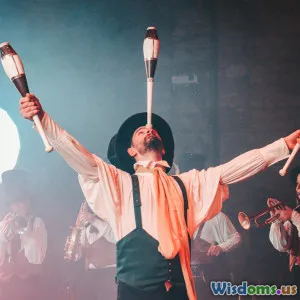
Innovative Tricks for Modern Magicians
6 min read Explore cutting-edge tricks that redefine magic for today's performers. (0 Reviews)
Innovative Tricks for Modern Magicians
Magic has always been about wonder and amazement, but as we move further into the 21st century, the art of magic is evolving. Today's magicians are not just entertainers; they are storytellers and innovators, using cutting-edge technology and creativity to engage audiences like never before. In this article, we will explore some innovative tricks that modern magicians are employing to captivate their audiences and breathe new life into age-old performances.
The Integration of Technology
1. Augmented Reality (AR) Magic
One of the most groundbreaking advancements in magic is the use of augmented reality. Magicians can now use AR to enhance their performances. For instance, a magician might use a smartphone app to project holograms that interact with physical objects on stage. This creates a layered effect where the audience is drawn into a world where reality and illusion blur.
Example: The AR Card Trick
Imagine a classic card trick where the magician asks a spectator to choose a card. Instead of simply revealing it, the magician activates an AR application that shows the chosen card floating above the spectator's hand. This unexpected twist not only enhances the visual appeal but also adds an element of surprise that keeps audiences engaged.
2. Digital Magic
Digital magic utilizes technology to create illusions that wouldn't be possible without it. This can include everything from simple smartphone tricks to elaborate multimedia presentations. For example, magicians can perform feats where they appear to read minds via text messages or create illusions on a live-streamed video.
Example: The Mind Reading App
A magician might set up a scenario where a spectator thinks of a word while the magician appears to read their mind using a specially designed app. The app could send the magician hints based on the spectator's reactions, creating a seamless and immersive experience.
Emphasizing Storytelling
3. Narrative-Driven Performances
Modern audiences crave stories, and successful magicians have adapted their performances to include strong narratives. By weaving a tale into their tricks, magicians can create emotional connections with their audience, making the experience more memorable.
Example: The Journey of the Card
Instead of just performing a card trick, a magician might tell a story about a journey the card takes. Each phase of the trick aligns with a part of the story, engaging the audience on both an emotional and intellectual level.
4. Character Development
Creating a character or persona is another effective technique. Whether it’s a whimsical wizard or a mysterious figure, having a strong character helps to draw the audience into the performance. This character can guide the audience through the narrative, making the magic feel more cohesive and engaging.
Incorporating Interactive Elements
5. Audience Participation
Modern magic thrives on interaction. By involving audience members in tricks, magicians can create personalized experiences that resonate more deeply. This could involve having audience members make choices that affect the outcome of the trick, thereby increasing their investment in the performance.
Example: Choice-Driven Magic
A magician could present several different magical effects and allow the audience to vote on which one they want to see. This not only keeps the audience engaged but also makes them feel like part of the show, creating a shared experience.
6. Social Media Integration
The rise of social media has transformed how magic is shared and consumed. Magicians can create short, shareable videos of their tricks, reaching larger audiences and gaining followers. By engaging with fans online, magicians can create a community around their performances.
Example: Viral Tricks
Creating a trick specifically designed for social media, such as a quick card trick that can be performed in under a minute, can help magicians reach new audiences and gain recognition.
Conclusion
The world of magic is continuously evolving, and modern magicians are at the forefront of this transformation. By embracing technology, focusing on storytelling, and fostering audience interaction, they are redefining what magic can be. Whether you're a performer looking for new ideas or a fan eager to explore the latest trends, these innovative tricks offer a glimpse into the future of magic. As we continue to push the boundaries of this ancient art form, one thing remains certain: the magic of today is more exciting than ever before.
Rate the Post
User Reviews
Popular Posts





















